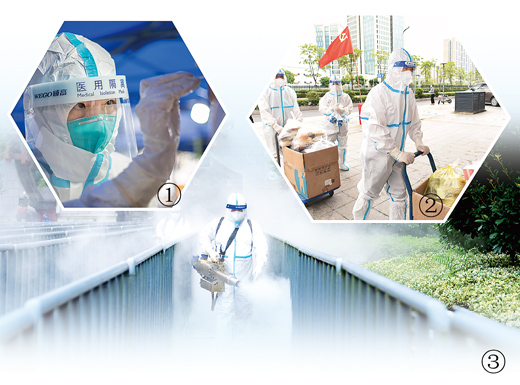Touching stories of people's all-out efforts in epidemic control during recent wave of COVID-19 in China
In a recent wave of COVID-19 in China, the country faced great pressure in controlling the outbreak and spread of the Delta variant. Between July and mid-August, China confirmed COVID-19 cases in 16 provinces and 150 medium and high-risk areas. The flareup in the local epidemic over the short period of time posed the most severe and complicated prevention and control situation in China this year.

1. A medical worker conducts a nucleic acid test on a resident at a neighborhood in Wuchang district, central China's Wuhan. (Xinhua/Wu Zhizun)
2. Party members deliver supplies to people under quarantine in Hanjiang district, Yangzhou city in east China. (People's Daily/Xia Cunxi)
3. A medical worker disinfects the entrance of a scenic area in Zhangjiajie, central China’s Hunan province. (Xinhua/Chen Sihan)
To aid the anti-pandemic efforts of relevant localities, the joint prevention and control mechanism of China’s State Council sent working groups to the frontlines. After about a month of arduous fighting, Nanjing in east China’s Jiangsu province downgraded all areas to low risk, and the last medium-risk area in the province, a residential community in the city of Yangzhou, was also eventually downgraded to low risk.
The facts have proven that China’s accumulated experience and methods in controlling the COVID-19 epidemic at home since last year are also capable of effectively handling the Delta Variant, according to a message released by the country’s National Health Commission on its website on Aug. 26.
A look at the stories of common people fighting against the local outbreak demonstrates why China is more than capable of continuing its successful handling of the virus.
Medical worker racks his brains to help a senior patient suffering from poor memory to recall her travel history
On July 27, more than two weeks after the first positive COVID case was reported in Nanjing city during the latest round of outbreaks, Ding Songning from the acute infectious disease department at the city’s disease control center couldn’t sleep for the entire day because he was busy carrying out an epidemiological investigation of a positive case.
The patient in question was an 80-year-old woman surnamed Wang, who was unable to clearly remember her travel history, making it difficult for Ding to press ahead with his work within a 24-hour window as he was required to do. Then, it occurred to Ding that the woman, who was suffering from chronic diseases, must have gone to pharmacies recently to purchase some medicine. After coming up with this clue, Ding aided the patient to recall her travel history piece by piece until he finally came up with an epidemiological investigation.
Based on contact survey data, Nanjing built 20 virus transmission models, which made the fight against the epidemic more efficient. By Aug. 15, the city had investigated more than 22,000 people suspected of being infected with COVID-19. According to Ding, thanks to the assistance of various departments, they were able to form a report on the travel history of a suspected COVID case within only 50 minutes; the police were then able to issue a report on the travel history of the suspected case within 5 hours; at which point, the local healthcare department was able to release an epidemiological investigation of the suspected case within 12 hours.
As a hub for studying and surveying COVID-19, the epidemiological investigation center for epidemic control in Nanjing deployed 50 healthcare experts and 80 police officers to carry out investigations. All the districts of Nanjing sent 450 groups with each consisting of three people—one police officer and two healthcare workers—with an aim to carrying out investigations. All relevant staff members were on standby 24 hours a day.
Ambulance driver and his wife work diligently at the frontline, longing for a reunion with their daughter
Leng Hailong is an ambulance driver in Yangzhou city. After the first COVID case was reported in the city during the latest outbreak, the city’s emergency rescue center immediately dispatched 38 transport teams consisting of vehicles carrying negative pressure facilities and 145 ambulances to transport COVID-19 patients. Leng was one of the drivers.
At 10 a.m. on Aug. 4, Leng was told by his superior to transport a patient to the hospital. Before starting off, he made a phone call to the patient’s community to inquire about its exact location and gathered information about the patient, such as which floor the patient lived on, in order to make sure that a stretcher could be used. Jiao Lu, Leng’s wife, also a colleague of his, was with him all along. The two cheered on each other by writing the Chinese characters “Jia You” (meaning “stay strong”) on the back of each other’s protective clothing before hitting the road.
When Leng was carrying the senior patient down the stairs, Jiao followed him closely behind while spraying disinfectants along the stairwell and onto the ground. When they returned to the emergency rescue center about two hours later, the couple carefully disinfected the ambulance and they themselves also went through strict disinfection procedures. When they were having a simple meal together, Leng made a video call to their daughter, whom they hadn’t seen for days due to their busy work. Though Jiao shed tears because she was unable to be with her daughter, she said resolutely that they must stay at their posts to fight the virus because they were needed at that moment. By Aug. 16, Yangzhou had transported a total of 17,900 people to quarantine centers established in surrounding cities.
Nurses conduct over 1,000 nucleic acid tests in one day
Guan Xiaoxi, a nurse from a community healthcare center in Wuhan, central China’s Hubei province, was among the many grassroots healthcare workers who made their due contributions in the fight against COVID-19 by earnestly performing their duties. In the evening of Aug. 2, the epidemiological investigation results showed that the seven people who tested positive for COVID-19 had travel histories related to multiple districts in Wuhan.
According to a previous notice released by the joint prevention and control mechanism of the State Council, which pointed out that after confirming the necessity of mass nucleic acid testing, it was imperative that any city with a total population of less than 5 million complete the testing of all residents within two days, and those cities with a total population of more than 5 million meanwhile had to complete the testing of all residents within three days. Wuhan, a city with a population of more than 10 million, fell into the second category.
On Aug. 3, the city dispatched a total of 28,000 medical workers, 13,000 community workers, 40,000 Party members, and 110,000 volunteers to 3,576 nucleic test sites. Guan was stationed at a testing site in Jiang’an district. Between Aug. 3 and 5, she worked a tight shift, and when she took off her protective clothing, she found herself soaked in sweat all over her body. “After the samples were delivered to the labs, they would be counted and tested immediately, and it would take about 8 hours for medical workers to get the results and upload them,” Guan explained. By Aug. 8, more than 11.28 million people had been tested in Wuhan, which was almost the city’s total population.
A race against death! A critically ill senior patient saved in Nanjing
At about 10 p.m. on Aug. 13, Chen Hui, a doctor for acute diseases from a hospital in Nanjing, performed an operation on an 85-year-old COVID-19 patient who also had high blood pressure and who had had a tumor removed from his body before.
The patient’s symptoms were very acute as he suddenly suffered breathing difficulties and had not urinated for over a period of 24 hours. When the operation started, the patient’s blood pressure dropped sharply and his heart rate was 130 beats per minute. After Chen opted to give the patient a trachea cannula, the man went back to breathing normally. However, after a short while, his heart rate soared to 200 beats per minute and his blood pressure then dropped to a lower level, and what was worse, a large pericardial effusion was found in the place around the patient’s heart, which could have prevented his heart from pumping normally.
Chen said that a pericardiocentesis with extended catheter drainage must be immediately performed to treat the effusion. Fortunately, the operation proved to be a success, with the patient’s blood pressure and heart rate both having returned to normal levels. At 3:30 a.m. on Aug 14, the patient was out of danger. The doctors and healthcare experts also tailored a treatment plan for the patient, enabling him to recover step by step.
During this latest COVID-19 outbreak, the numbers of COVID-19 cases in Nanjing and Yangzhou reached above 200 and more than 500, respectively. Jiangsu province, which administers the two cities, established 67 teams consisting of 4,786 medical workers to rescue and treat severely ill patients. By Aug. 25, both cities had been cleared of moderately ill patients and critically ill patients, according to a news conference briefing on COVID control in Jiangsu province.
Photos
Related Stories
- Chinese mainland reports 59 new locally transmitted COVID-19 cases
- Nearly 2.15 bln doses of COVID-19 vaccines administered in China
- Brunei receives second batch of Sinopharm vaccine donation from China
- Chinese mainland reports 22 new locally transmitted COVID-19 cases
- China's biotechnology helps Serbia fight pandemic, make scientific progress: Serbian expert
Copyright © 2021 People's Daily Online. All Rights Reserved.










